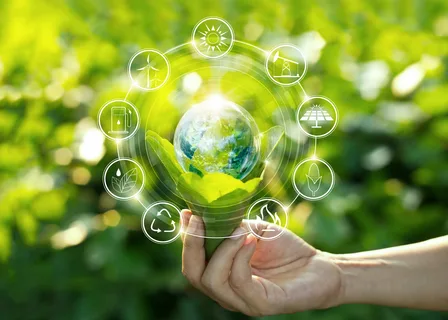The Blooming Business: Uncovering the Environmental Footprint of the Floral Industry

Flowers are not only beautiful to look at, but they also play a crucial role in the environment. They provide food and habitat for insects, birds, and other animals and help pollinate plants. Nabeel Shamshad, a gardening enthusiast and founder of Garden Cove Produce, said that Flowers also contribute to the overall health of ecosystems by improving air quality and reducing soil erosion. In addition to their environmental benefits, flowers significantly impact our lives. They bring joy and happiness and are often used to celebrate special occasions or express emotions. Whether it’s a bouquet of roses on Valentine’s Day or a field of wildflowers in bloom, flowers can uplift our spirits and connect us with nature.
Key Takeaways
- Flowers have a significant impact on the environment and contribute to its beauty.
- The global flower market is large and constantly evolving, with trends that reflect changing consumer preferences.
- The floral industry has a significant environmental footprint, with concerns around carbon emissions, water use and pollution, and pesticide use.
- Sustainable flower production practices and innovations are emerging, but challenges remain around waste and recycling.
- Consumers can make informed choices to support a more sustainable and responsible floral industry.
The Global Flower Market: Size, Scope, and Trends
The global flower market is a multi-billion dollar industry that spans across continents. According to a report by Spherical Insights & Consulting, the global floriculture market size was valued at USD 53.6 billion in 2022 and is expected to reach USD 101.9 billion by 2032 at a compound annual growth rate (CAGR) of 6.6% from 2022 to 2032 1. The market is driven by increasing consumer demand for flowers, the growing popularity of floral arrangements in events and weddings, and the rise of e-commerce platforms for flower delivery.
In recent years, there have been several trends shaping the flower industry. One of the notable trends is the shift towards sustainable and locally sourced flowers. Consumers are becoming more conscious about the environmental impact of their purchases. They are seeking out flowers that are grown using organic practices and without harmful chemicals. Another trend is the rise of online flower delivery services, which have made it easier for consumers to order flowers from the comfort of their homes. Additionally, there has been an increased interest in unique and exotic flowers and a growing demand for dried flowers and preserved floral arrangements.
The Environmental Footprint of the Floral Industry: Key Issues and Concerns
While flowers bring beauty and joy, the floral industry also has a significant environmental footprint. One key issue is the carbon emissions associated with flower production and transportation. Flowers are often grown in countries with favorable climates and then transported long distances to reach consumers in other parts of the world. This transportation contributes to greenhouse gas emissions and air pollution.
Another concern is the water use and pollution associated with flower farming and processing. Flowers require large amounts of water to grow, straining local water resources, especially in areas where water scarcity is already an issue. Additionally, using fertilizers and pesticides in flower farming can lead to water pollution, as these chemicals can leach into nearby water bodies and harm aquatic life.
The Carbon Footprint of Flower Production and Transportation
The floral industry is significantly concerned about the carbon footprint of flower production and transportation. As mentioned earlier, flowers are often grown in countries with favorable climates and then transported long distances to reach consumers in other parts of the world. This transportation contributes to greenhouse gas emissions, particularly from burning fossil fuels in airplanes, trucks, and ships.
Several strategies can be implemented to reduce carbon emissions. One approach is to promote local flower production, where flowers are grown closer to the consumer market. This reduces the need for long-distance transportation and helps to lower carbon emissions. Another strategy is to improve transportation efficiency by using more fuel-efficient vehicles and optimizing delivery routes. Additionally, investing in renewable energy sources for flower farms and implementing energy-saving practices can help to reduce carbon emissions associated with flower production.
Water Use and Pollution in Flower Farming and Processing
Water use and pollution are significant concerns in flower farming and processing. Flowers require large amounts of water to grow, straining local water resources, especially in areas where water scarcity is already an issue. Additionally, using fertilizers and pesticides in flower farming can lead to water pollution, as these chemicals can leach into nearby water bodies and harm aquatic life.
Sustainable water management practices can be implemented to address these issues. This includes drip irrigation systems that deliver water directly to the plant roots, reducing water waste. It also involves implementing water recycling and rainwater harvesting systems to minimize water consumption. Furthermore, organic farming practices can be adopted to reduce synthetic fertilizers and pesticides, which can help prevent water pollution.
Pesticides and Chemicals: Risks to Human Health and the Environment
Using pesticides and chemicals in flower farming risks human health and the environment. Pesticides are used to control pests and diseases that can damage flowers. Still, they can also negatively impact beneficial insects, birds, and other wildlife. Additionally, pesticide exposure can pose health risks to farm workers and consumers.
To mitigate these risks, there is a need to promote alternatives to harmful chemicals in flower farming. Integrated pest management (IPM) practices can involve cultural, biological, and chemical control methods to manage pests. This approach reduces reliance on synthetic pesticides and promotes using natural predators and beneficial insects to control pests. Furthermore, organic farming practices, which prohibit the use of synthetic pesticides and promote the use of natural fertilizers, can be adopted.
Waste and Recycling in the Flower Industry: Challenges and Opportunities
Waste management is a significant challenge in the flower industry. Flowers have a limited shelf life; once they wilt or die, they become waste. Additionally, waste iswaste, such as trimmings and packaging materials, is generated during flower processing. Proper waste management is crucial to minimizing the floral industry’s environmental impact.
One opportunity for sustainable waste management is composting. Flower waste can be composted and turned into nutrient-rich soil amendments. This reduces waste and provides a valuable resource for flower farms and gardens. Another opportunity is recycling. Packaging materials, such as cardboard boxes and plastic wraps, can be recycled to reduce the demand for virgin materials. Additionally, efforts can be made to reduce packaging waste by using eco-friendly materials and implementing packaging design strategies that minimize waste.
Sustainable Flower Production: Best Practices and Innovations
Sustainable flower production involves implementing best practices and innovations that minimize the environmental impact of flower farming. One best practice is the use of organic farming methods, which prohibit the use of synthetic fertilizers and pesticides. Organic farming promotes soil health and biodiversity, and it helps to protect the environment from pollution.
Another best practice is the use of renewable energy sources for flower farms. Solar panels can be installed to generate clean energy, reducing reliance on fossil fuels. Additionally, energy-saving practices, such as using energy-efficient lighting and equipment, can be implemented to reduce energy consumption.
Several emerging technologies can help improve the sustainability of flower production. For example, vertical farming systems can maximize space utilization and reduce water consumption. These systems involve growing plants vertically stacked layers, using artificial lighting and hydroponic or aeroponic systems. Another innovation is the use of drones for precision agriculture. Drones can monitor crop health, detect pests and diseases, and optimize irrigation practices, leading to more efficient resource use.
Consumer Awareness and Responsibility: How to Make Informed Choices
Consumers can play a crucial role in promoting sustainability in the flower industry. By making informed choices when buying flowers, consumers can support growers who prioritize sustainable practices and encourage others to do the same.
Consumers can make informed choices by looking for certifications and labels that indicate sustainable practices. For example, the Fairtrade certification ensures that flowers are produced in an environmentally and socially responsible manner. The Rainforest Alliance certification guarantees that flowers are grown using sustainable farming practices that protect ecosystems and support local communities.
Consumers can also choose to buy locally grown flowers, as this reduces the carbon emissions associated with transportation. Additionally, opting for seasonal and native flowers can help to support biodiversity and reduce the need for excessive water and chemical inputs.
Read More: Why you must plan a visit to the city of Bangalore?
Towards a More Sustainable and Responsible Floral Industry
In conclusion, the floral industry has a significant impact on the environment. Still, there are opportunities to make it more sustainable and responsible. By addressing key issues such as carbon emissions, water use, pesticide use, and waste management, the floral industry can minimize its environmental footprint and contribute to a healthier planet.
Consumers also have a role in promoting sustainability in the flower industry. By making informed choices and supporting growers who prioritize sustainable practices, consumers can drive demand for environmentally friendly flowers and encourage others to adopt sustainable practices.
Ultimately, a more sustainable and responsible floral industry is not only beneficial for the environment but also for the well-being of communities and future generations. By working together, we can ensure that the beauty of flowers continues to enrich our lives without compromising the health of our planet.











